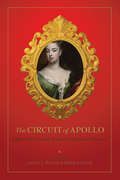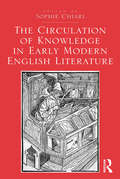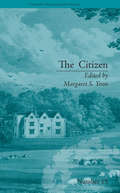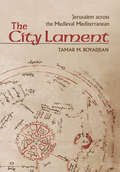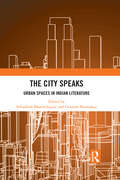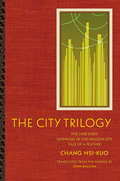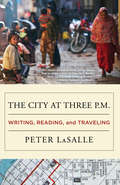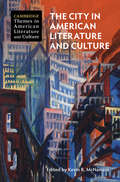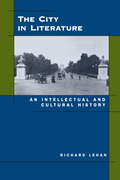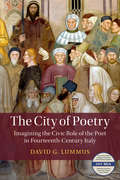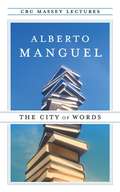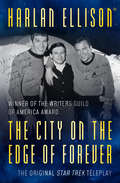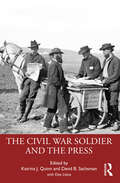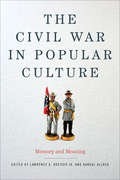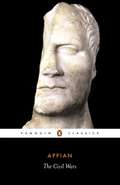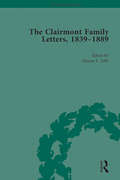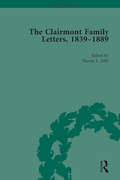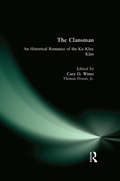- Table View
- List View
The Circuit of Apollo: Eighteenth-Century Women's Tributes to Women (Early Modern Feminisms)
by Katharine Kittredge Susan S. Lanser Betty A. Schellenberg Christine Gerrard Catherine Ingrassia Shelley King Claudia Thomas Kairoff Natasha Duquette Kathryn R. King Nicolle Jordan Laura TallonWritten by a combination of established scholars and new critics in the field, the essays collected in Circuit of Apollo attest to the vital practice of commemorating women’s artistic and personal relationships. In doing so, they illuminate the complexity of female friendships and honor as well as the robust creativity and intellectual work contributed by women to culture in the long eighteenth century. Women’s tributes to each other sometimes took the form of critical engagement or competition, but they always exposed the feminocentric networks of artistic, social, and material exchange women created and maintained both in and outside of London. This volume advocates for a new perspective for researching and teaching early modern women that is grounded in admiration.Distributed for the University of Delaware Press
The Circulation of Knowledge in Early Modern English Literature
by Sophie ChiariWith its many rites of initiation (religious, educational, professional or sexual), Elizabethan and Jacobean education emphasized both imitation and discovery in a struggle to bring population to a minimal literacy, while more demanding techniques were being developed for the cultural elite. The Circulation of Knowledge in Early Modern English Literature examines the question of transmission and of the educational procedures in16th- and 17th-century England by emphasizing deviant practices that questioned, reassessed or even challenged pre-established cultural norms and traditions. This volume thus alternates theoretical analyses with more specific readings in order to investigate the multiple ways in which ideas then circulated. It also addresses the ways in which the dominant cultural forms of the literature and drama of Shakespeare’s age were being subverted. In this regard, its various contributors analyze how the interrelated processes of initiation, transmission and transgression operated at the core of early modern English culture, and how Christopher Marlowe, William Shakespeare and Thomas Middleton, or lesser known poets and playwrights such as Thomas Howell, Thomas Edwards and George Villiers, managed to appropriate these cultural processes in their works.
The Circulation of Poetry in Manuscript in Early Modern England (Material Readings in Early Modern Culture)
by Arthur F. MarottiThis study examines the transmission and compilation of poetic texts through manuscripts from the late-Elizabethan era through the mid-seventeenth century, paying attention to the distinctive material, social, and literary features of these documents. The study has two main focuses: the first, the particular social environments in which texts were compiled and, second, the presence within this system of a large body of (usually anonymous) rare or unique poems. Manuscripts from aristocratic, academic, and urban professional environments are examined in separate chapters that highlight particular collections. Two chapters consider the social networking within the university and London that facilitated the transmission within these environments and between them. Although the topic is addressed throughout the study, the place of rare or unique poems in manuscript collections is at the center of the final three chapters. The book as a whole argues that scholars need to pay more attention to the social life of texts in the period and to little-known or unknown rare or unique poems that represent a field of writing broader than that defined in a literary history based mainly on the products of print culture.
The Citizen: by Ann Gomersall (Chawton House Library: Women's Novels #15)
by Margaret S YoonAnn Gomersall’s The Citizen (1790) is an epistolary novel, written over two volumes. Gomersall came out of the merchant class in Leeds and little else is known about her, but she began writing to raise funds for her merchant husband to re-enter business after he lost his money. This is the first modern critical edition of Gomersall’s work.
The City Lament: Jerusalem across the Medieval Mediterranean
by Tamar M. BoyadjianPoetic elegies for lost or fallen cities are seemingly as old as cities themselves. In the Judeo-Christian tradition, this genre finds its purest expression in the book of Lamentations, which mourns the destruction of Jerusalem; in Arabic, this genre is known as the ritha al-mudun. In The City Lament, Tamar M. Boyadjian traces the trajectory of the genre across the Mediterranean world during the period commonly referred to as the early Crusades (1095–1191), focusing on elegies and other expressions of loss that address the spiritual and strategic objective of those wars: Jerusalem. Through readings of city laments in English, French, Latin, Arabic, and Armenian literary traditions, Boyadjian challenges hegemonic and entrenched approaches to the study of medieval literature and the Crusades.The City Lament exposes significant literary intersections between Latin Christendom, the Islamic caliphates of the Middle East, and the Armenian kingdom of Cilicia, arguing for shared poetic and rhetorical modes. Reframing our understanding of literary sources produced across the medieval Mediterranean from an antagonistic, orientalist model to an analogous one, Boyadjian demonstrates how lamentations about the loss of Jerusalem, whether to Muslim or Christian forces, reveal fascinating parallels and rich, cross-cultural exchanges.
The City Speaks: Urban Spaces in Indian Literature
by Goutam Karmakar Subashish BhattacharjeeThis book studies the significance and representation of the ‘city’ in the writings of Indian poets, graphic novelists, and dramatists. It demonstrates how cities give birth to social images, perspectives, and complexities, and explores the ways in which cities and the characters in Indian literature coexist to form a larger literary framework of interpretations. Drawing on the theoretical concepts of Western urban thinkers such as Henri Lefebvre, Georg Simmel, Walter Benjamin, Edward Soja, David Harvey, and Diane Levy, as well as South Asian thinkers such as Ashis Nandy, Arjun Appadurai, Vinay Lal, and Ravi Sundaram, the book projects against a seemingly monolithic and homogenous Western qualification of urban literatures and offers a truly unique and contentious presentation of Indian literature. Unfolding the urban-literary landscape of India, the volume lays the groundwork for an urban studies approach to Indian literature. It will be of great interest to scholars and students of literature, especially Indian writing in English, urban studies, and South Asian studies.
The City Trilogy: Five Jade Disks, Defenders of the Dragon City, and Tale of a Feather
by John Balcom Chang Chsi-KuoTaiwan's most innovative science fiction writer presents three tales of intrigue, espionage, betrayal, political strife, time travel, and Chinese history and mysticism.
The City Trilogy: Five Jade Disks, Defenders of the Dragon City, and Tale of a Feather (Modern Chinese Literature from Taiwan)
by Hsi-kuo ChangTaiwan's most innovative science fiction writer presents three tales of intrigue, espionage, betrayal, political strife, time travel, and Chinese history and mysticism. After thousands of years of civil unrest and countless wars, the weary Huhui people of Sunlon City have once again succumbed to a ruthless and overpowering enemy. In Five Jade Disks, the first book in the trilogy, the imperialistic Shan have enslaved the inhabitants of Sunlon City and imposed a harsh martial order. As the Shan fight to retain control of the restless Huhui natives, an unstable rebel alliance prepares to win back its homeland. Amidst the confusion of revolt, Miss Qi, a determined young girl, emerges as an unlikely leader. With the help of her friends and the loyal Green Snake Brotherhood, Miss Qi discovers that an ancient cult and its insidious and unusually powerful leader may hold the key to the rebels' victory—or may yet be the cause of their undoing. As she rushes to put the pieces together, the rebels, divided by internal factions, strive to band together in a heroic attempt to overthrow the Shan. The story continues in Defenders of the Dragon City. The Shan have been defeated, but the victory celebrations of the Huhui are quickly brought to an end. After deserting Sunlon City, the Shan regroup and return for one final and bitter attempt to destroy the weakened rebel forces. During their exile, the Shan turn their aggressions against the indigenous races of the Huhui planet, a colorful mix of peaceful tribes resembling serpents, eagles, and leopards. Forced into the war to save their remaining territory, the indigenous peoples join the Huhui in their continuing struggle against the Shan.The third novel, Tale of a Feather, opens with images of chaos and devastation. The conflict with the Shan has left the city in flames, and refugees are fleeing in droves through the main gates. Taking advantage of the turmoil, a ruthless dictator assumes control of the weak interim government and begins a treacherous campaign to eliminate his adversaries. In this volatile atmosphere, Miss Qi continues her desperate search to discover the origin of the mysterious Bronze Statue Cult and come to terms with the dark power it wields over her people.The trilogy, first published in Taiwan in the late 1980s and early 1990s and widely considered to be a modern classic, is now presented for the first time in English and in a single volume. In these allegorical tales, Chang confronts some of the most serious and divisive issues of our time, including the burden of history and the ravages of oppression, racism, and ethnic displacement.
The City at Three PM
by Peter LasalleIn "The City at Three PM," award-winning fiction writer Peter LaSalle offers 11 startlingly original personal essays dealing with his longtime quest for world travel. These literary errands range from driving recklessly across the county to seek out Saul Bellow in Chicago to settling in for long evenings at a pub in Dublin with Christy Brown, the celebrated Irish author afflicted with cerebral palsy who typed with his toes. In Buenos Aires LaSalle senses metaphysical transport while investigating Borges' work; in Cameroon he attends the wonderful opening of a small bookstore; in Hollywood he finds himself caught in a crazy mob scene while researching the work of 1930s master American novelist and screenwriter Nathanael West; in Tunisia he follows in the footsteps of Flaubert at the ruins of ancient Carthage. And those are just some of the adventures. Having first appeared in distinguished publications here and abroad, including "The Best American Travel Writing," these are beautifully crafted pieces, heartfelt, honest, observant, and often moving toward genuine transcendence. Overall they conjure up those fine moments when travel intersects with the important role of literature in our lives, in this case yielding writing entirely unique and satisfying.
The City in American Literature and Culture (Cambridge Themes in American Literature and Culture)
by Kevin R. McNamaraThe city's 'Americanness' has been disputed throughout US history. Pronounced dead in the late twentieth century, cities have enjoyed a renaissance in the twenty-first. Engaging the history of urban promise and struggle as represented in literature, film, and visual arts, and drawing on work in the social sciences, The City in American Literature and Culture examines the large and local forces that shape urban space and city life and the street-level activity that remakes culture and identities as it contests injustice and separation. The first two sections examine a range of city spaces and lives; the final section brings the city into conversation with Marxist geography, critical race studies, trauma theory, slow/systemic violence, security theory, posthumanism, and critical regionalism, with a coda on city literature and democracy.
The City in Literature: An Intellectual and Cultural History
by Richard LehanThis sweeping literary encounter with the Western idea of the city moves from the early novel in England to the apocalyptic cityscapes of Thomas Pynchon. Along the way, Richard Lehan gathers a rich entourage that includes Daniel Defoe, Charles Dickens, Emile Zola, Bram Stoker, Rider Haggard, Joseph Conrad, James Joyce, Theodore Dreiser, F. Scott Fitzgerald, and Raymond Chandler. The European city is read against the decline of feudalism and the rise of empire and totalitarianism; the American city against the phenomenon of the wilderness, the frontier, and the rise of the megalopolis and the decentered, discontinuous city that followed. Throughout this book, Lehan pursues a dialectic of order and disorder, of cities seeking to impose their presence on the surrounding chaos. Rooted in Enlightenment yearnings for reason, his journey goes from east to west, from Europe to America. In the United States, the movement is also westward and terminates in Los Angeles, a kind of land's end of the imagination, in Lehan's words. He charts a narrative continuum full of constructs that "represent" a cycle of hope and despair, of historical optimism and pessimism.Lehan presents sharply etched portrayals of the correlation between rationalism and capitalism; of the rise of the city, the decline of the landed estate, and the formation of the gothic; and of the emergence of the city and the appearance of other genres such as detective narrative and fantasy literature. He also mines disciplines such as urban studies, architecture, economics, and philosophy, uncovering material that makes his study a lively read not only for those interested in literature, but for anyone intrigued by the meanings and mysteries of urban life.
The City in the Distance
by Jean-Luc NancyFINALIST, 38th ANNUAL FRENCH-AMERICAN FOUNDATION TRANSLATION PRIZEExploring the ever-changing philosophy of city life with Jean-Luc NancyIn The City in the Distance, Jean-Luc Nancy embarks on nothing less than a philosophy of the city. Drawing on his widely discussed accounts of sense and of the fraught question of community, Nancy views the city as the site of a disposition that is constantly undergoing metamorphoses.Far from an abstract account, Nancy attends in the most concrete way possible to the workings of a city not typically taken as paradigmatic, Los Angeles. As Jean-Christophe Bailly suggests in his foreword, Nancy joins Walter Benjamin in thinking the city not from an external vantage point, but on its own terms.
The City of Poetry: Imagining the Civic Role of the Poet in Fourteenth-Century Italy (Cambridge Studies in Medieval Literature)
by David LummusWhat did it mean to be a poet in fourteenth-century Italy? What counted as poetry? In an effort to answer these questions, this book examines the careers of four medieval Italian poets (Albertino Mussato, Dante Alighieri, Francesco Petrarch, and Giovanni Boccaccio) who wrote in both Latin and the Italian vernacular. In readings of defenses of poetry, speeches and letters on public laurel-crowning ceremonies, and other theoretical and poetic texts, this book shows how these poets viewed their authorship of poetic works as a function of their engagement in a human community. Each poet represents a model of the poet as a public intellectual - a poet-theologian - who can intervene in public affairs thanks to his authority within texts. The City of Poetry provides a new historicized approach to understanding poetic culture in fourteenth-century Italy which reshapes long-standing Romantic views of poetry as a timeless and sublimely inspired form of discourse.
The City of Words (The CBC Massey Lectures)
by Alberto ManguelIn the 2007 CBC Massey Lectures, Alberto Manguel leads us back into our literary tradition to find insight about one of the most contentious issues of our time: the rise of ethnic nationalism. The end of ethnic nationalism -- building societies around sets of common values -- seems like a good idea. But something is going wrong. Manguel suggests we should look at what stories have to teach us about society. With wit and erudition, Manguel looks at what visionaries, poets, novelists, essayists, and filmmakers have to say about building societies. From Cassandra to Jack London, the Epic of Gilgamesh to the computer Hal in 2001: A Space Odyssey, Don Quixote to Atanarjuat: The Fast Runner, Manguel draws fascinating and revelatory parallels between the personal and political realities of our present-day world and those of myth, legend, and story.
The City on the Edge of Forever: The Original Teleplay
by Harlan EllisonThe original teleplay that became the classic Star Trek episode, with an expanded introductory essay by Harlan Ellison, The City on the Edge of Forever has been surrounded by controversy since the airing of an "eviscerated" version--which subsequently has been voted the most beloved episode in the series' history. In its original form, The City on the Edge of Forever won the 1966-67 Writers Guild of America Award for best teleplay. As aired, it won the 1967 Hugo Award. The City on the Edge of Forever is, at its most basic, a poignant love story. Ellison takes the reader on a breathtaking trip through space and time, from the future, all the way back to 1930s America. In this harrowing journey, Kirk and Spock race to apprehend a renegade criminal and restore the order of the universe. It is here that Kirk faces his ultimate dilemma: a choice between the universe--or his one true love. This edition makes available the astonishing teleplay as Ellison intended it to be aired. The author's introductory essay reveals all of the details of what Ellison describes as a "fatally inept treatment" of his creative work. Was he unjustly edited, unjustly accused, and unjustly treated?
The Civil Power of the News
by Jackie HarrisonThis landmark book is concerned with the civil power of the news. This power can be seen in the ways the news engages with public sentiment through a focus on three invariant civil concerns: identity, legitimacy and risk. The book analyses how news stories engage with these concerns to make civil and anti-civil judgements, which influence public sentiment and determine the boundaries we place and maintain around the society we live in. Through historical and contemporary examples of this boundary shaping and maintenance, The Civil Power of the News presents a bold and original account of the architecture of news, the influence it has on our conceptions of civility, and, ultimately, the power it wields.
The Civil War Soldier and the Press
by David B. Sachsman Katrina J. Quinn Dea LisicaThe Civil War Soldier and the Press examines how the press powerfully shaped the nation’s understanding and memory of the common soldier, setting the stage for today’s continuing debates about the Civil War and its legacy. The history of the Civil War is typically one of military strategies, famous generals, and bloody battles, but to Americans of the era, the most important story of the war was the fate of the soldier. In this edited collection, new research in journalism history and archival images provide an interdisciplinary study of citizenship, representation, race and ethnicity, gender, disability, death, and national identity. Together, these chapters follow the story of Civil War soldiers, from enlistment through battle and beyond, as they were represented in hometown and national newspapers of the time. In discussing the same pages that were read by soldiers’ families, friends, and loved ones during America’s greatest conflict, the book provides a window into the experience of historical readers as they grappled with the meaning and cost of patriotism and shared sacrifice. Both scholarly and approachable, this book is an enriching resource for undergraduate and graduate courses in Civil War history, American history, journalism, and mass communication history.
The Civil War Soldier and the Press
by David B. Sachsman Katrina J. Quinn Dea LisicaThe Civil War Soldier and the Press examines how the press powerfully shaped the nation’s understanding and memory of the common soldier, setting the stage for today’s continuing debates about the Civil War and its legacy.The history of the Civil War is typically one of military strategies, famous generals, and bloody battles, but to Americans of the era, the most important story of the war was the fate of the soldier. In this edited collection, new research in journalism history and archival images provide an interdisciplinary study of citizenship, representation, race and ethnicity, gender, disability, death, and national identity. Together, these chapters follow the story of Civil War soldiers, from enlistment through battle and beyond, as they were represented in hometown and national newspapers of the time. In discussing the same pages that were read by soldiers’ families, friends, and loved ones during America’s greatest conflict, the book provides a window into the experience of historical readers as they grappled with the meaning and cost of patriotism and shared sacrifice.Both scholarly and approachable, this book is an enriching resource for undergraduate and graduate courses in Civil War history, American history, journalism, and mass communication history.
The Civil War in Popular Culture: Memory and Meaning
by Randal Allred“An important read for anyone trying to sort through the current social and political controversy over the question of how do we memorialize the Civil War.” —Strategy PageDividing the nation for four years, the American Civil War resulted in 750,000 casualties and forever changed the country’s destiny. The conflict continues to resonate in our collective memory, and U.S. economic, cultural, and social structures still suffer the aftershocks of the nation’s largest and most devastating war. Over a century and a half later, portrayals of the war in books, songs, cinema, and other cultural media continue to draw widespread attention and controversy.In The Civil War in Popular Culture: Memory and Meaning, editors Lawrence A. Kreiser Jr. and Randal Allred analyze American depictions of the war across a variety of mediums, from books and film to monuments and battlefield reunions to reenactments and board games. This collection examines how battle strategies, famous generals, and the nuances of Civil War politics translate into contemporary popular culture. This unique analysis assesses the intersection of the Civil War and popular culture by recognizing how memories and commemorations of the war have changed since it ended in 1865.
The Civil Wars
by AppianTaken from Appian's Roman History, the five books collected here form the sole surviving continuous historical narrative of the era between 133-35 BC - a time of anarchy and instability for the Roman Empire. A masterly account of a turbulent epoch, they describe the Catiline conspiracy; the rise and fall of the First Triumvirate; the murder of Julius Caesar; the formation of the Second Triumvirate by Antonius, Octavian, and Lepidus; and brutal civil war. A compelling depiction of the decline of the Roman state into brutality and violence, The Civil Wars portrays political discontent, selfishness and the struggle for power - a struggle that was to culminate in a titanic battle for mastery over the Roman Empire, and the defeat of Antony and Cleopatra by Octavian in 31 BC
The Clairmont Family Journals 1855-1885
by Sharon JoffeThis edition presents the extant journals of Pauline Clairmont (1825–1891) and Wilhelm Clairmont (1831–1895), the niece and nephew of Claire Clairmont (1798–1879) who was Mary Shelley’s (1797–1851) stepsister. It also includes a journal originally attributed to Pauline but which likely was Walter Gaulis Clairmont’s (1868–1958; Wilhelm’s son). All three journals are currently deposited in the Carl H. Pforzheimer Collection of Shelley and His Circle at the New York Public Library. Pauline and Wilhelm spent many years living and working in places like Australia and the Banat and their adventures are recorded in their journals. Pauline wrote a series of sixteen journals cataloguing her life; however, except for one journal, all the remaining journals have been lost. Her extant journal, written primarily in English but with French and German entries, documents her struggles in the Australian outback during the 1850s and her relationship with William Henry Suttor, Junior, who would later become a pastoralist and a politician. Pauline’s journal tells of her love for Suttor, her disappointment at his rejection, and her musings about her life in Australia. In his journal, Wilhelm chronicles his attempts to purchase a farm in Europe while Walter provides us with an account of his 8-day Austrian expedition. This new edition brings together these three journals, thereby extending our understanding of the Shelley-Clairmont family. The edition includes an introduction to the primary Godwin-Shelley-Clairmont circle and a chapter on the history of life writing. The editor provides extensive editorial notes and carefully researched chapters to contextualize The Clairmont Family Journals: 1855–1885.
The Clairmont Family Letters, 1839 - 1889: Volume I (The Pickering Masters)
by Sharon JoffeThis book is the first of two volumes in an edited collection that brings together the unpublished letters of the extended Clairmont family, for the first time. The letters, housed in the Carl H. Pforzheimer Collection of Shelley and His Circle at the New York Public Library, inform our understanding of the Shelley-Godwin circle through the experiences and thoughts of their descendants. The correspondence also enables us to see into the contemporary social history of nineteenth-century families living in Europe and Australia, dealing with subjects such as the conflicts in Europe, woes in the European financial markets, and the effects of Australian pioneer life on immigrants to that country. The Clairmont Family Letters, 1839–1889 improves upon scholarship made by other Shelley and Clairmont collections and is furnished with editorial notes and apparatus from Dr. Sharon Joffe. These volumes will be of significant interest to scholars in British Romanticism.
The Clairmont Family Letters, 1839 - 1889: Volume II (The Pickering Masters)
by Sharon JoffeThis book is the second of two volumes in an edited collection that brings together the unpublished letters of the extended Clairmont family, for the first time. The letters, housed in the Carl H. Pforzheimer Collection of Shelley and His Circle at the New York Public Library, inform our understanding of the Shelley-Godwin circle through the experiences and thoughts of their descendants. The correspondence also enables us to see into the contemporary social history of nineteenth-century families living in Europe and Australia, dealing with subjects such as the conflicts in Europe, woes in the European financial markets, and the effects of Australian pioneer life on immigrants to that country. The Clairmont Family Letters, 1839–1889 improves upon scholarship made by other Shelley and Clairmont collections and is furnished with editorial notes and apparatus from Dr. Sharon Joffe. These volumes will be of significant interest to scholars in British Romanticism.
The Clansman: An Historical Romance of the Ku Klux Klan
by Thomas Dixon Thomas WintzThomas Dixon was a lawyer, North Carolina state legislator, Baptist minister, lecturer, and novelist. This novel, an abridgement by Cary Wintz was originally published in 1905. It reflects turn-of-the-century attitudes most southerners had about Republican rule during Reconstruction.
